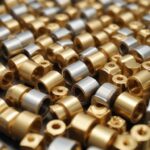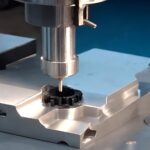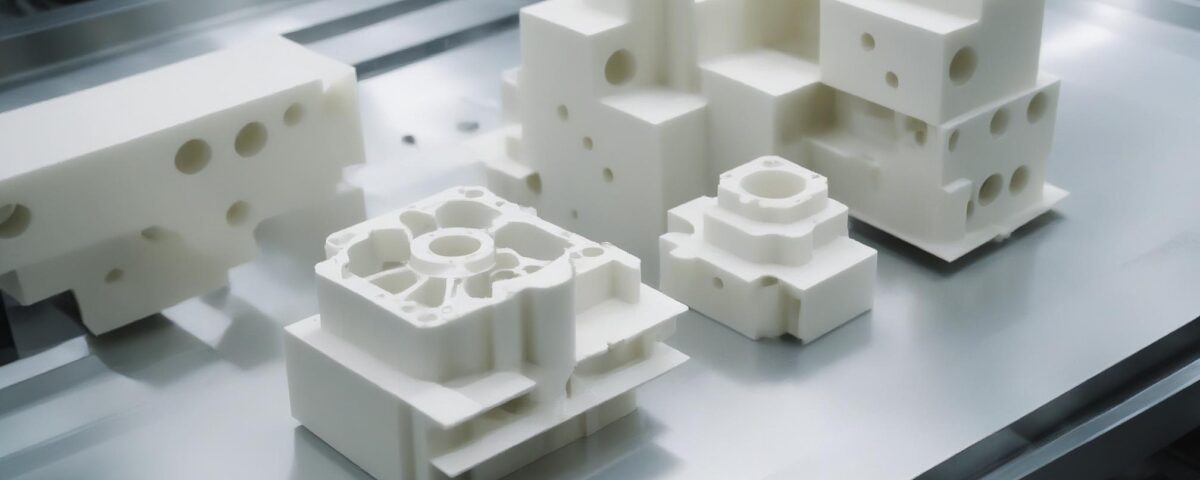
Brass CNC Machining vs. Other Metals: What Sets Brass Apart?
30 July 2024
What Is CNC Machining and How Does It Work? A Complete Overview in 2024
2 August 2024Introduction
Struggling with CNC machining challenges when working with Delrin? You’re not alone. Many machinists find themselves frustrated by the unique characteristics of this engineering plastic, which can lead to unexpected issues during milling. From achieving the perfect surface finish to selecting the right tools, the nuances of machining Delrin can be daunting.
Mastering the art of milling Delrin involves understanding its unique properties, selecting the right tools, and fine-tuning your CNC machining process. Delrin, known for its high strength, low friction, and dimensional stability, requires careful consideration to achieve optimal results. This guide will walk you through the essential steps to successfully machine Delrin, from setup to finishing touches.
Stay tuned as we delve into each aspect of CNC milling Delrin, ensuring you’re equipped to handle any challenges and achieve high-quality outcomes.

Understanding Delrin and Its Properties
Delrin, a trademarked name for polyoxymethylene (POM), is a highly versatile engineering plastic with a range of impressive properties that make it a popular choice in CNC machining. To effectively work with Delrin, it’s essential to understand its chemical composition, physical attributes, thermal properties, and both its advantages and limitations.
1. Chemical Composition and Structure
Chemical Composition
Delrin is a type of acetal resin, which is a polymer made from formaldehyde. The chemical structure of Delrin is characterized by a repeating chain of methylene (CH2) groups, which are linked by oxygen atoms. This structure is often represented as:
−(−CH2−O−)n−-(-CH_2-O-)_n-−(−CH2−O−)n−
where "n" denotes the number of repeating units in the polymer chain.
Molecular Structure
The molecular structure of Delrin contributes significantly to its mechanical and chemical properties. The polymer chains are tightly packed and held together by strong intermolecular forces, which result in a material that is both rigid and tough. The crystalline nature of Delrin also contributes to its high dimensional stability and low thermal expansion.
2. Physical Properties
Strength and Durability
Delrin boasts high tensile strength, with values typically ranging from 60 to 70 MPa (megapascals). This makes it highly resistant to deformation under load. Its impact resistance is also notable, with the material capable of withstanding significant stress without cracking or breaking.
Low Friction and Wear Resistance
One of Delrin's standout features is its low coefficient of friction. It provides excellent sliding properties, which reduces friction and wear between moving parts. This property makes Delrin ideal for applications involving gears, bearings, and other components subject to regular motion.
Impact Resistance and Dimensional Stability
Delrin’s impact resistance ensures it can endure mechanical shocks and stresses. Additionally, the material’s dimensional stability means it maintains its shape and size under varying conditions, such as temperature fluctuations and mechanical loads. This stability is crucial for precision engineering applications where tolerance is key.
3. Thermal Properties
Heat Resistance and Thermal Stability
Delrin has a melting point of approximately 175°C (347°F), which indicates its ability to withstand high temperatures before softening. It also has good thermal stability, meaning it can maintain its mechanical properties and dimensional integrity at elevated temperatures. However, prolonged exposure to high temperatures may lead to thermal degradation, so it’s important to stay within recommended temperature limits during machining and application.
Thermal Expansion
Delrin exhibits minimal thermal expansion, which is beneficial for precision components that require stable dimensions across a range of temperatures. This low thermal expansion helps prevent warping and dimensional changes in parts subjected to temperature variations.
4. Advantages and Disadvantages of Delrin
Benefits of Using Delrin
- High Mechanical Strength: Delrin’s robust mechanical properties make it suitable for high-stress applications.
- Low Friction and Wear Resistance: Its low friction coefficient and excellent wear resistance enhance the performance and lifespan of moving parts.
- Dimensional Stability: The material maintains its shape and size well, making it ideal for precision machining.
- Chemical Resistance: Delrin is resistant to many chemicals, including solvents, oils, and fuels, which extends its utility in harsh environments.
- Ease of Machining: Delrin is relatively easy to machine, providing a good surface finish and high-quality results with minimal tool wear.
Limitations and Challenges
- Not UV Resistant: Delrin can degrade when exposed to ultraviolet (UV) light over time, which limits its use in outdoor applications.
- Brittleness at Low Temperatures: At very low temperatures, Delrin can become more brittle, which may affect its performance in cold environments.
- Cost: Compared to some other engineering plastics, Delrin can be more expensive, which might impact budget considerations for large-scale projects.
Preparing for CNC Milling of Delrin
Successfully milling Delrin requires meticulous preparation to ensure high-quality results and efficient machining. The preparation process involves selecting the right tools and equipment, making thoughtful tooling considerations, and setting up and calibrating your CNC machine properly. Here’s a step-by-step guide to prepare for CNC milling of Delrin:
Selecting the Right Tools and Equipment
1. Types of CNC Machines Suitable for Delrin
When choosing a CNC machine for milling Delrin, consider the following:
- CNC Milling Machines: Standard vertical and horizontal CNC mills are typically suitable for Delrin. Ensure the machine has a good spindle speed range and rigidity to handle the material effectively.
- High-Speed Machining Centers: For achieving finer finishes and higher precision, high-speed machining centers are advantageous due to their ability to operate at higher RPMs and handle delicate operations.
2. Recommended Cutting Tools
Selecting the right cutting tools is crucial for effective milling of Delrin:
- End Mills: Use sharp, high-quality end mills made from carbide or high-speed steel. Carbide tools are preferred for their hardness and wear resistance.
- Drills: Choose drills with a geometry optimized for plastics. High-speed steel (HSS) or carbide drills with a sharp point and a proper angle are recommended.
- Specialized Tools: Consider using tools designed specifically for plastics, such as single-flute end mills or those with a positive rake angle to reduce chip adhesion and improve surface finish.
Tooling Considerations
1. Tool Material and Coatings
- Carbide Tools: Carbide tools are highly recommended for machining Delrin due to their hardness and resistance to wear. They maintain their cutting edge longer than HSS tools.
- Coatings: Although coatings are less critical for Delrin, some tools with non-stick coatings can help reduce material build-up and extend tool life.
2. Tool Geometry and Design
- Flute Design: Tools with fewer flutes (e.g., single-flute or two-flute) are often preferred for plastics like Delrin. Fewer flutes improve chip removal and reduce the risk of clogging.
- Rake Angle: Positive rake angles are beneficial for plastics, as they aid in cutting and chip formation, reducing the likelihood of material melting or sticking to the tool.
3. Importance of Sharp, Well-Maintained Tools
Maintaining sharp tools is crucial for achieving a clean cut and high-quality finish. Dull tools can cause excessive heat buildup, poor surface finish, and increased tool wear. Regularly inspect and replace tools as needed to ensure optimal performance.

Machine Setup and Calibration
1. Ensuring Machine Accuracy and Precision
Proper machine setup is essential for accurate milling:
- Check Machine Alignment: Ensure the CNC machine is correctly aligned and calibrated. Misalignment can lead to inaccuracies in the machined parts.
- Inspect Spindle and Tool Holders: Verify that the spindle is secure and tool holders are properly installed. Any wobble or misalignment can affect the quality of the finished part.
2. Calibration Techniques for Optimal Results
- Tool Length Offsets: Accurately measure and set tool length offsets to ensure the CNC machine knows the exact position of each tool.
- Workpiece Setup: Securely clamp the Delrin workpiece to prevent movement during machining. Use precision fixtures and ensure the workpiece is correctly aligned with the machine axes.
- Test Cuts: Perform test cuts on a small piece of Delrin to fine-tune settings and verify that the machine is performing as expected before starting the final machining process.
CNC Milling Process for Delrin
CNC milling of Delrin requires a precise and well-planned approach to achieve optimal results. From designing the machining process to setting cutting parameters and handling the workpiece, each step is crucial for successful milling. Here’s a comprehensive guide to the CNC milling process for
Delrin: Designing the Machining Process
1. Creating and Optimizing CAD/CAM Models
- CAD Models: Start by creating a detailed 3D model of the part you intend to machine using Computer-Aided Design (CAD) software. Ensure that all dimensions, tolerances, and features are accurately represented.
- CAM Programming: Use Computer-Aided Manufacturing (CAM) software to convert the CAD model into a machining plan. CAM software will generate the toolpaths, cutting strategies, and instructions needed for the CNC machine.
- Optimization: Optimize the CAD/CAM model and toolpaths to reduce machining time and enhance efficiency. Consider factors such as tool engagement, cutting direction, and material removal strategies to improve performance and surface finish.
2. Importance of Precise Measurements and Tolerances
- Dimensional Accuracy: Ensure that all dimensions and tolerances specified in the design are achievable with the chosen tools and machining parameters. Delrin’s dimensional stability helps, but precise measurements are still crucial.
- Feature Placement: Verify the placement of features, such as holes, slots, and pockets, to ensure they are correctly aligned and meet design specifications. Accurate positioning is essential for functional parts and assemblies.
Cutting Parameters
1. Speed and Feed Rates
- Spindle Speed: Delrin typically requires higher spindle speeds compared to metals. Recommended spindle speeds range from 8,000 to 15,000 RPM, depending on the tool diameter and machining conditions.
- Feed Rate: Set an appropriate feed rate to balance cutting efficiency and surface quality. For Delrin, feed rates generally range from 0.1 to 0.5 mm/tooth (0.004 to 0.020 inches/tooth), depending on tool size and cutting conditions.
2. Depth of Cut and Step-Over
- Depth of Cut: Adjust the depth of cut based on the tool and material removal rate. For Delrin, the depth of cut can range from 0.5 to 2 times the tool diameter, depending on the rigidity of the setup and the complexity of the part.
- Step-Over: The step-over distance, or the width of each pass, should be set to ensure efficient material removal while maintaining a good surface finish. Typical step-over values for Delrin range from 30% to 50% of the tool diameter.
3. Cooling and Lubrication Requirements
- Cooling: Although Delrin doesn’t require extensive cooling, using air blasts or minimal coolant can help manage heat and chip removal. Excessive heat can cause the material to soften and affect surface quality.
- Lubrication: For most Delrin milling operations, lubrication is minimal. However, if machining is particularly aggressive or the tool is showing signs of wear, consider using a light mist of cutting fluid or lubricant to improve cutting performance and tool life.
Handling and Clamping
1. Techniques for Securing Delrin Workpieces
- Workholding: Use appropriate clamping fixtures or vises to securely hold the Delrin workpiece. Ensure that the clamping system does not deform the material or affect the accuracy of the machining process.
- Workpiece Positioning: Position the workpiece accurately in relation to the machine axes. Align it to ensure proper cutting and avoid issues such as tool deflection or uneven wear.
2. Ensuring Stability and Minimizing Movement
- Fixture Stability: Ensure that the clamping system is rigid and stable. Any movement or vibration during machining can affect the quality of the finished part and lead to inaccuracies.
- Material Handling: Handle Delrin workpieces carefully to avoid introducing stress or deformation before machining. Proper handling practices help maintain the integrity of the material and the precision of the finished part.
Quality Control and Inspection
1. Methods for Inspecting Machined Parts
- Measurement Tools: Use precision measurement tools such as calipers, micrometers, and height gauges to inspect critical dimensions and tolerances. Check both linear dimensions and geometric features.
- Surface Finish: Evaluate the surface finish using visual inspection and surface roughness gauges. Delrin should have a smooth surface with minimal tool marks if the machining parameters are correctly set.
2. Ensuring Adherence to Specifications and Tolerances
- Dimensional Checks: Regularly compare the machined part to the design specifications to ensure it meets all dimensional and tolerance requirements.
- Feature Verification: Verify that all features, such as holes and slots, are correctly positioned and machined to the specified depth and diameter.
Post-Machining Considerations
Once the CNC milling process for Delrin is complete, several post-machining steps are necessary to ensure the final part meets the required specifications and is ready for use. This phase includes finishing techniques, troubleshooting common issues, and maintaining tools and equipment. Here’s a comprehensive guide to the post-machining considerations for Delrin:
Finishing Techniques
1. Deburring and Edge Finishing
- Deburring: After machining, Delrin parts often have burrs or sharp edges that need to be removed. Use deburring tools, such as hand deburring blades or rotary deburring tools, to carefully smooth out these areas.
- Edge Finishing: For a clean, professional appearance, use fine sandpaper or abrasive pads to smooth out any rough edges or tool marks. This step is crucial for parts that require a high-quality surface finish or are intended for aesthetic applications.
2. Surface Polishing and Treatment
- Polishing: Achieve a high-gloss finish by polishing Delrin parts with a plastic polish or fine abrasive compounds. Use a soft cloth or polishing wheel to apply the polish and enhance the surface clarity.
- Surface Treatment: For some applications, additional surface treatments may be applied, such as coatings or sealants, to further protect the material and improve its performance in specific environments.
Troubleshooting Common Issues
1. Identifying and Addressing Common Milling Problems
- Chip Formation: If chips are not forming correctly or are sticking to the tool, check the feed rates and spindle speed. Adjusting these parameters can help achieve better chip removal and prevent clogging.
- Surface Finish Issues: Poor surface finish can result from dull tools, incorrect feed rates, or excessive heat. Inspect the tools for sharpness, and review the machining parameters to ensure they are suitable for Delrin. Adjusting the cutting parameters or using a different tool may improve the finish.
2. Solutions for Improving Machining Outcomes
- Tool Wear: Regularly inspect and replace worn or damaged tools to maintain machining quality. Sharp, well-maintained tools are essential for achieving a good surface finish and precise dimensions.
- Heat Management: Excessive heat during machining can lead to material deformation or poor surface quality. Ensure proper cooling and ventilation to manage heat and prevent overheating.
Maintenance of Tools and Equipment
1. Regular Maintenance Practices for CNC Machines
- Routine Cleaning: Regularly clean the CNC machine to remove chips, dust, and other debris that can affect machine performance and accuracy. Keep the work area and machine components clean to ensure smooth operation.
- Lubrication: Follow the manufacturer’s recommendations for lubricating machine parts, including spindles, bearings, and linear guides. Proper lubrication reduces friction and wear, extending the lifespan of the equipment.
2. Tool Care and Replacement Schedules
- Tool Inspection: Regularly inspect cutting tools for signs of wear, damage, or dullness. Replace tools as needed to maintain machining quality and prevent issues such as poor surface finish or tool breakage.
- Tool Storage: Store tools properly to prevent damage and maintain sharpness. Use tool holders or racks that protect the cutting edges and keep tools organized.
Conclusion
Mastering the art of milling Delrin requires a comprehensive understanding of both the material and the machining process. From preparing the CNC machine and selecting the right tools to managing cutting parameters and post-machining finishing, each step plays a critical role in achieving high-quality results.
Delrin is a highly versatile engineering plastic with outstanding mechanical properties, including strength, low friction, and dimensional stability. Proper preparation involves choosing the appropriate CNC machine, tools, and settings to suit Delrin’s unique characteristics. During machining, precise control over cutting parameters, handling, and quality inspection is essential to produce accurate and well-finished parts.
Post-machining considerations, such as deburring, polishing, and troubleshooting, help ensure that the final product meets the desired specifications and performs reliably in its intended application. Regular maintenance of tools and equipment further enhances the efficiency and longevity of the machining process.




